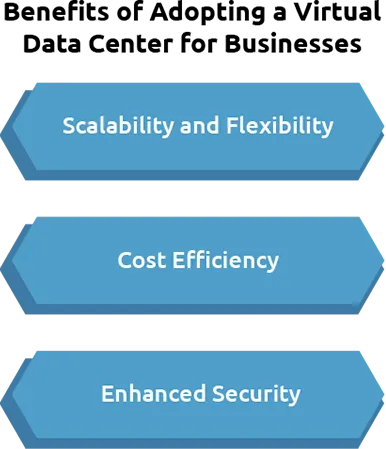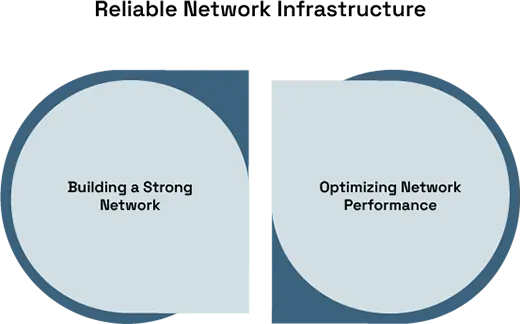Technology continues to develop fast and this has completely transformed business IT infrastructure management methods. Developing entities need IT solutions that give security together with cost-effectiveness & high system performance capabilities. A virtual data center service in cloud computing allows businesses to automatically distribute workloads without requiring costly physical hardware networks. Cloud computing data centers allow businesses straightforward integration to focus on innovation & growth while simplifying operational difficulties.

1. Scalability and Flexibility
Businesses must allocate considerable funds for both hardware replacement and maintenance when using standard IT infrastructure systems. Cloud provider data centers allow businesses to increase their resource capabilities according to their demand needs. Through a virtual data center within cloud computing, organizations can access appropriate computing power according to their needs, although they avoid the common issue of unnecessary provisioning. By dynamically scaling operations, businesses can improve their performance & achieve better cost optimization together with demand variations.
2. Cost Efficiency
Operating a database center from on-premises requires businesses to pay high costs that cover infrastructure acquisition along with energy use, security management, and continuous maintenance costs. Cloud computing removes the need for capital investments so businesses can use a per-usage payment system. Shared resources are available in public cloud data center systems which reduce operational costs while maintaining performance dependability. Long-term sustainability for businesses is maintained through their avoidance of hardware risks of becoming outdated.
3. Enhanced Security
Cloud-based service transition demands security attention however, data centers in cloud computing provide powerful protection measures against cyber threats. These deployment systems use current-generation security defenses with advanced encrypted operations and detection of automation in addition to support protocols and scheduled security audits. The substantial investment of hyper-scale computing companies in cybersecurity technology to ensure data integrity thus protecting their systems from risk of breaches and unauthorized access. Cloud networks at data centers utilize multilayer authentication protocols that are accelerated by artificial intelligence to perform threat analysis to improve security measures.
4. Business Continuity and Disaster Recovery
Cloud computing protects business operations from disruptions that may occur because of natural disasters and hardware failures along with cyberattacks. Users experience uninterrupted business continuity because cloud computing includes disaster recovery functionality in virtual data centers. Businesses maintain quick data recovery of their critical information through data replication features alongside automated backups and failover strategies. The resilience of data center cloud networks allows businesses to prevent revenue loss when unexpected interruptions occur because they ensure fast recovery and low maintenance periods.
5. Performance Optimization
Hyperscale cloud computing data centers provide businesses with capabilities to use high-performance computing processes that optimize operational efficiency. These data facilities utilize their purpose-built design to execute large-scale workloads effectively resulting in fast data management, improved applications, and complete cloud computing service connectivity. The combination of real-time analytics with large dataset processing and customer transaction management leads businesses to acquire better performance coupled with reliability because of hyperscale cloud computing data centers.
6. Sustainability and Environmental Benefits
Organizations have started making sustainability their priority focus. Cloud-based data centers represent global data center sustainability trends because they decrease both carbon emissions and power usage. Hyperscale cloud computing data centers deploy energy-saving technologies that utilize liquid cooling systems and AI control of power usage as well as renewable energy infrastructure. The sustainability shift allows companies to fulfill their CSR requirements and contributes to worldwide sustainability aims.
7. Seamless Integration with AI, Automation, and Emerging Technologies
Current businesses experience fundamental changes from AI and automation while needing flexible IT infrastructure systems. A datacenter virtual machine connected to AI tools including Grok AI, allows businesses to automate processes while improving data processing and decision-making. AI predictive analytics systems allow efficient resource management thus, businesses minimize costs & improve their service delivery.
Additional infrastructure investments become unnecessary for businesses since cloud computing data centers integrate machine learning and IoT with blockchain technology capabilities.
8. Improved Collaboration and Remote Work Capabilities
Remote workers have become more common because organizations need employees to reach applications and data without interruptions. Through cloud computing employees can safely store and share data between diverse locations as they perform remote work. The workplace efficiency benefits from virtual desktops together with shared drives and real-time collaboration platforms. Public storage services encrypt cloud data so employees can access their work remotely and maintain security benefits as well as complete tasks from any location without network limitations.
9. Future-Proofing IT Infrastructure
Organizations need to implement IT infrastructures that are both acceptable and designed for future success because of fast data center trend development. Agility in competitive markets becomes possible for organizations moving to cloud-based data centers because they can tap into edge computing and hybrid cloud and software-defined networking (SDN) solutions. Data-center trends demand company alignment to ensure proactive responses against upcoming challenges while achieving sustainable business goals.
10. Reliable Network Infrastructure
Businesses that depend on cloud services need to maintain an efficient network. Cloud computing centers deploy low-latency communication systems through advanced connectivity to allow users access without interruptions to their applications databases and virtual workspaces. The fast networking infrastructure improves both business workflow efficiency and enhances user satisfaction levels.

Conclusion
Executive organizations use virtual data centers in cloud computing to achieve strategic advancements in innovation as well as operational efficiency while maintaining sustainability goals. Modern advancements in data center industry trends provide businesses with beneficial marketplace advantages by implementing cloud-based data centers in their operations. Companies of every size will achieve enduring success through operational excellence by making the move to cloud solutions.








